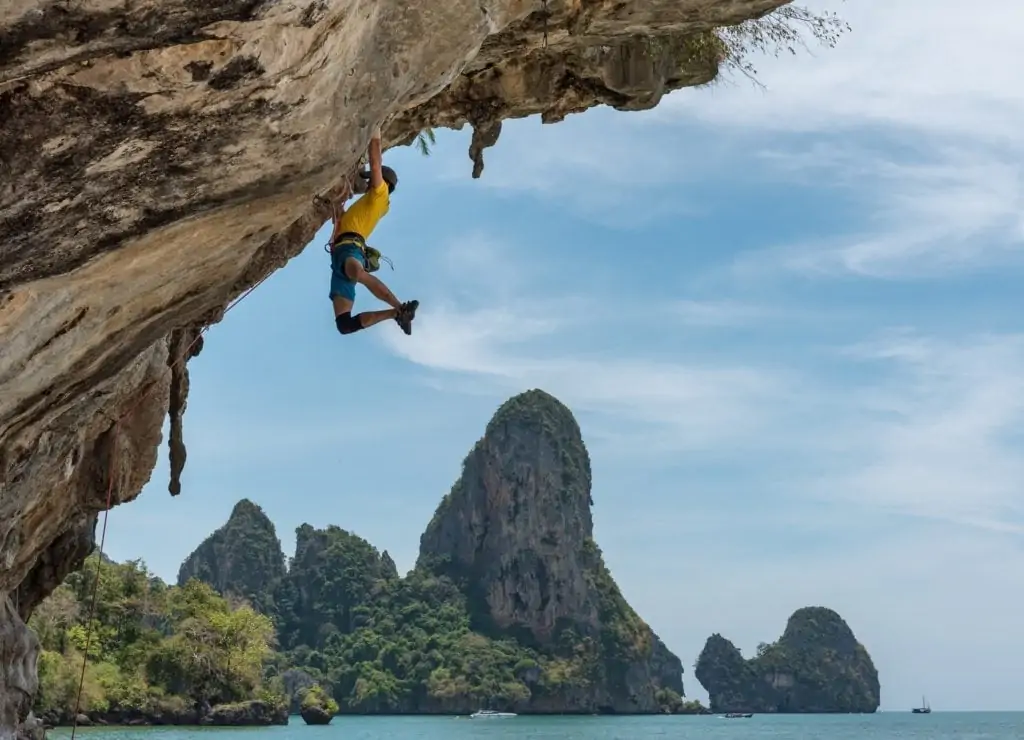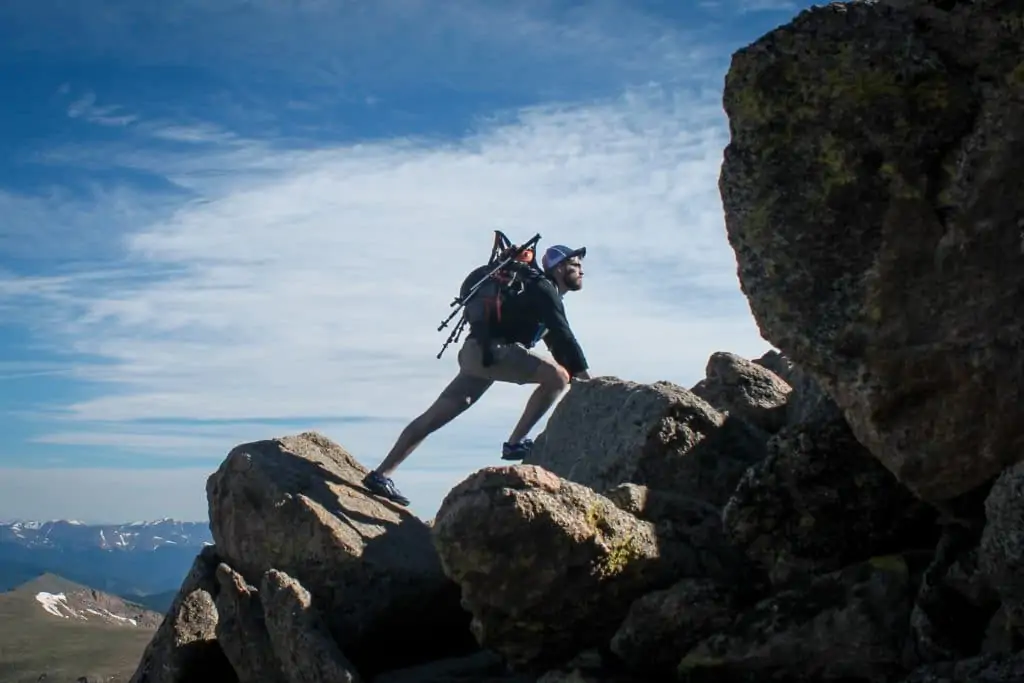I was hooked from the first time I went climbing.
I quickly fell in love with the physical and mental challenges of the sport.
Climbing is a fun sport for a ton of reasons, but one of the key reasons why I think people love it is because goals are mainly personally driven. Ultimately you’re not competing against anyone else except yourself. You’re in full control for the most part throughout every send (at least in an indoor situation).
Watching climbers better than me work their way gracefully up the walls, I knew I wanted to become a better rock climber, and I wanted to get better fast.
Now that I’ve climbed for over two years, I’ve had enough time to take a step back and think about what I did right and what I did wrong when I was first starting out. If you’re a beginner rock climber still working on regularly sending V0s to V2s or 5.8s to 5.10bs, here is what I found most helpful in breaking through my first climbing plateaus:
1. Establish a regular climbing routine.
The easiest way to get better at anything in life is through deliberate practice. The same applies to climbing. If you want to become a better climber, you have to climb more.
The best part about when you’re first starting out is that you’ll get to experience beginner gains. I categorize this in bouldering as the moment when you’re going from V0 and V1s to V2s and maybe a few V3s.
Look at your schedule and map out at least two climbing days in the week. Consistency is critical and don’t train in back-to-back days. At this point, your muscles and body aren’t familiar enough with the strain that climbing can put on it so climbing consecutive days is not going to help much in helping you experience gains and will likely result in some minor injury.
If you feel good with two climbing sessions a week, try upping your frequency to three times a week. To be honest, I don’t think you need to climb more than 3X a week to improve at these levels, so I recommend taking at least one rest day between every climb.
For me, my goal isn’t to become a professional rock climber. I just like to climb and want to be good enough to send tougher routes. It’s a marathon, not a sprint. That means that it’s more important that I stay healthy and can keep climbing for years than to push my body to the point of exhaustion and injury.
To hold yourself accountable, I recommend setting a total climbing session goal for a 12-week period. Getting into a climbing rhythm is easily the first foundational step to becoming a better climber fast.
2. Be mindful of your body weight.
One of the funniest things to see in a climbing gym is when a person who has experience strength training in a more conventional sense (think benchpress, squats, deadlifts, etc.) tries to brute force his or her way up a wall. It doesn’t work that way in climbing.
So much of climbing is knowing how you’re distributing your body weight on particular moves. Beginner rock climbers struggle with this because they’re still working on overcoming their fear of heights, of falling, or of their arms not being able to last long on the walls.
You will be able to climb longer if you remain incredibly mindful of your body weight on every move.
The best way to become mindful of this is to imagine your body is cut in half, and then think about what percentage of your weight is on each side with each move. If you ever feel like you’re more than 60 or 65% on one side, you’re likely going to have to make a big move to compensate for that. Big moves mean you’re spending a lot of energy. The more big moves you make, the faster you’re going to start feeling pumped.
I think of my arms as each being worth 20% of my body weight and my legs as 30%. This reality is that your arms are always going to give out before your legs, just because of the difference in mass. Push up with your legs as much as you can to take off the strain from your arms.
3. Keep your body as close to the wall as possible.
Beginners tap out early in their climbing sessions because they’re putting too much pressure on their arms to support their body on the wall. When you keep your body close to the wall, you use less of a pulling action on your arms, making it easier for you to scale up a problem comfortably.
This tip relates to the previous point of being mindful of your body weight. If you don’t keep your body close to the wall, each move that you’re going to make is going to require more collective movement than it needs. This again means you’re spending more energy than you may need to at that moment.
4. Shift your hips left and right when it feels right.
A lot of beginners will keep their body positioned square facing the wall. This is a mistake. The reason why is because sometimes it’s easier if you pivot your hips left and right towards and away from the wall to shift your weight distribution. Again, it all comes back to being mindful of your body weight.
Pivoting your body to the sides reduces some of the strain that you can put on your body when you’re just square facing the wall. If you watch great climbers in your local climbing gym, they all do this because it makes it easier to make progressive moves up a wall.
5. Grab your climbing holds confidently.
One of the most common things you’ll see with beginning rock climbers is that they grip multiple times on the same hold. I’m not going to lie; this is a habit that I just became aware of myself two years into climbing. Bad habits are hard to break! So don’t make this mistake.
While it can be tempting when you’re first starting out to focus on completing each route you’re trying, it can be more meaningful to become comfortable with grabbing once on a hold. This means when you make your next move, you do not move your hand after you’ve gripped the next hold. The common mistake into reposition the hand a few times until you feel “secure.” What this does though is waste energy that you could be using to extend your climbing session or on a tougher move.
It can be helpful to stick to VBs and V0s and focus on the way you’re grabbing holds to reduce how often you do this. Be intentional about every next movement.
6. Commit to the move.
This is something that I still grapple with today as a climber. Maybe you’re regularly sending V1s and V2s, and now you’re moving on up to V3s. Great work! Usually, V3s have one tougher move than the V2s — this move will require some commitment. It might be a bigger distanced grab than your standard V2, or a mini-dyno. Whatever it is, go for it.
There’s a great Netflix documentary called Valley Uprising. In it, climbing legend Lynn Hill talks about how if you’re not going 100% every time, you’re going to fail. And I cannot agree more.
If you ever look around the gym at any level of climber, the reasons for them failing to send a route when it’s within their skill level usually come down to something less than a 100% commit to the move. I know it’s scary, you’re still a beginner, but you have to get comfortable at going for the grab.
Each intentional failure that has a learning attached to it will get you closer to sending that route. Just do it.
7. Keep breathing throughout the problem.
When I first started top-roping, I was terrified of how high up I was. To be honest, I’ve always been afraid of heights growing up. To combat this, I found that focusing just on my breathing in these moments was essential for keeping my cool and making sure my muscles were getting enough oxygen as I progressed up a problem.
Mastering your breathing is so critical to climbing well. Take a long deep inward breath as you make lateral and upward movements. See if you can understand how fast or slow your heart is at that moment. Climbing is so rewarding because it helps you get better in tune with your body. You start to understand what works and doesn’t work for you.
8. At least once every three sessions, push your upper limit.
The best way to break through V0s and V1s is to try more V2s. Crazy, right? Shockingly the way you get better and send tougher routes is by familiarizing yourself with what the next grade entails. Build your confidence in your core competencies, then push yourself a little harder in your third session.
This is easier advice to give than actually to do. Even today, I’ve been climbing between V4s and V5s pretty steadily for about a year or so, and it wasn’t until this year when I started testing out V6s that I realized that I actually could send a few of them.
Same goes for top-roping — for the longest time I thought the highest grade I could do was 5.10d, maybe 5.11a. Then I tried a 5.11d and sent it. The only way to find out if you can do it is to try.
9. Log your climbing progress.
I’m biased here since the origin of this site is due to the climbing log I started doing this year, but if I could go back to my first year of climbing, I would have loved if I had logged my sessions. Ever since I started logging, I’ve become so much more aware of my strengths and weaknesses as a climber, and more intentional about pushing myself.
There is no better way to hold yourself accountable towards meeting your climbing goals. Also, it’s cool looking back a few months later at the progress you’ve made over time. All it takes is a moleskin and a pen. I personally use the Moleskine Classic Notebook and G-2 Pilot. You can also do it on your phone. When I forget my notebook, I just do it in my Notes app.
There you have it, nine tips to help you get through your first climbing plateau and to start sending tougher routes. I promise if you commit to working on one of these tips every week, you’ll find yourself becoming a better climber really fast.
I saw quick initial wins in my climbing when I set a regular routine, and I’m sure you will too!





